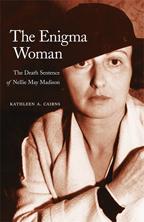The Enigma Woman: The Death Sentence of Nellie May Madison

In her astonishingly well-written account of California’s first female death row inmate, Kathleen Cairns weaves the story of domestic violence and the influence of the media into her telling of one woman’s life. Nellie May Madison shot her husband in their Southern California apartment in March 1934. During this time period, the media easily conflated Nellie with the film noir femme fatal image that was popular at the time. From the introduction to the text, we know that Nellie was eventually released from prison before the courts took her life, and we also know that domestic violence and sexual abuse were the cause of this. But Cairns writes the story so well that the actual facts of the case unfold in the same way that the general public must have learned of them seventy years ago. The compelling story and Cairns' captivating writing keeps you turning each page wondering what will happen next in this horrific case.
More than just a true crime story about a woman battling the California court system, Cairns’ investigation is a critical look on the position of married women during the Great Depression. Discussing issues such as socially constructed feminine norms and the refusal of a court system to recognize that a man could sexually assault his own wife, the overarching themes of the text bridge together Nellie’s struggles with the expectations of her society. Even more interesting is Cairns’ analysis of the women’s prison system in California. During the time, the purpose of having an all-women’s prison was to be able to reward the women with good behavior in order to set them on the road to “virtue.” Virtue was defined as “the ability [of the female prisoners] to support themselves until marriage and domesticity—the ultimate goal.” Set with this as a backdrop, it’s amazing that Nellie May Madison, who was nicknamed in the press as the “Enigma Woman," the “much-married” woman or as a woman “good with ponies and pistols,” was ever able to escape the prison system.
Combining a critique of social norms and the power that the media has over profiling criminals, with the events of one woman’s astounding life, Cairns’ historical text is a pleasure to read on multiple levels. It’s smart, well written and astonishingly addictive.